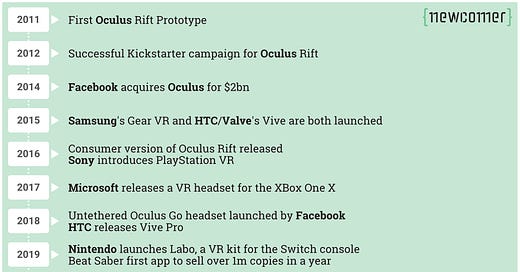VR Market Share & Headset Shipments: 11 Charts to Make Sense of the Metaverse Ahead of the Apple Vision Pro
Metaverse and VR hype peaked in 2021 during the pandemic. Will it recover?
Apple is preparing to release the Vision Pro at a time when interest in existing virtual and augmented reality devices has fallen from its peak.
Worldwide augmented reality (AR) and virtual reality (VR) device shipments peaked in 2021 at 11.2 million, according to our latest data post created by data scientist Wenqi Shao.
After the end of the pandemic, the metaverse hype died down. Searches for “metaverse” topped out in late 2021 when Facebook changed its name to Meta.
But Apple has the power to create a market for new devices, having established widespread demand for tablets, digital watches, and wireless headphones.
With the Vision Pro announcement, Apple immediately joins Meta as one of the two companies to watch in the headset space. Meta itself showed off a new version of its virtual reality device, the Meta Quest, the same week as Apple’s Vision Pro announcement.
This post is sponsored by Intercom
An AI Bot You Can Trust
Fin can’t burn its mouth on hot pizza. Or wave at someone who wasn’t waving at them. Fin can resolve half of your customer support tickets instantly before they reach your team.
Meet Fin. A breakthrough AI bot by Intercom — ready to join your support team today.
Benedict Evans recently published an essay on Apple and Meta’s divergent hardware strategies: “Meta, today, has roughly the right price and is working forward to the right device. Apple has started with the right device and will work back to the right price.”
Big tech giants clearly see something here: Microsoft has its HoloLens device line. Google pioneered the space with its discontinued Glass product and is expected to launch a successor later this year.
We decided to take stock of the current state of virtual reality, augmented reality, and digital worlds with 11 charts ahead of the Vision Pro’s release early next year. Data from IDC, Crunchbase, Wikipedia, Google Trends, SteamDB, Road to VR, and The Small Business Blog.
Meta has dominated the headset market
With over two-thirds of devices and growing, Meta is the closest thing that “virtual reality” has to an 800-pound gorilla.
We’ll have to see what happens when Apple and Google get in the mix, but this is a big head start.
Meanwhile, second place goes to Valve’s Steam in a minor surprise — not bad for a privately-held video game developer.
Headset shipments peaked in 2021
We will see if these trends reverse with the arrival of the new headsets, but it’s not a good sign to see a product category decline.
The same dataset actually has the decline continuing into 2023 with a 54% decrease year-over-year through the first quarter of 2023. Interest in the existing stock of headset devices is falling.
Nobody is looking for the metaverse
After Facebook changed its name to Meta, everyone was wondering what “metaverse” meant. Since then, searches for “metaverse” have plummeted.
Virtual reality, as hyped as it is, has nearly always lagged behind other buzzwords like “blockchain” and “artificial intelligence.”
Seeing not so clearly with VR headsets
If we’re looking for a reason to believe that Apple could catalyze the space like they did with smartphones, this may be it: the Vision Pro looks to be the highest resolution device on the market.
The Vision Pro will have 23 million pixels across two screens, approximately double the pixel count in the next highest device. Apple has gone all-in on making sure that their headset fools the eye into feeling like reality, including with a larger field of vision than their competitors.
While Apple has not released official specs, online estimates indicate Apple’s upcoming headset could have a 110-120 degree field of view and its 23 million pixels across both displays would roughly translate to a “3800 x 3000” resolution, which is almost 4x the resolution of previous headsets.
Venture capitalists’ headset excitement fluctuates
As the headset market has searched for a platform to justify the hype, venture dollars have ebbed and flowed.
For a while it seemed like Magic Leap might be the breakout startup. Founded in 2010, Magic Leap raised about $4 billion, according to PitchBook, in its pursuit of a mass market augmented reality device. That effort ultimately came up short. The Saudis reportedly took control of the struggling augmented reality company in late 2022.
Investor dollars in augmented and virtual reality technology peaked in 2018 when investors deployed over $4.6 billion, thanks in part to large funding rounds in companies like SenseTime.
Another small peak in 2021 saw some massive deals, such as a $300 million Series D for fellow augmented reality player Niantic, the developer of Pokémon Go.
Meta’s platform is growing slowly
Even with all the question marks, there are some positive signs. Meta’s Quest content store surpassed $1.5 billion cumulative revenue in October 2022, with 40 titles grossing more than $10 million in revenue and “roughly 1 in 3” seeing revenue in the millions of dollars.
For example, Meta’s Beat Saber — which reminds me of Tap Tap Revolution, what once counted for a “killer app” back in the days of the iPhone 4 — is estimated to have earned over $255 million in lifetime revenues.
Meta hasn’t shared new revenue data since October 2022. The last numbers they gave suggested growth may have somewhat decelerated, but the gaming industry tends to ramp up considerably in Q4.
Meet Fin. A breakthrough AI bot by Intercom — ready to join your support team today.
Not many new VR titles on Steam
Steam, the largest video game platform, had over a thousand VR games released in 2017.
That has slowly declined — more recent years have seen closer to 600 new VR games. Developers haven’t gone all-in on VR in a way that suggests it’s more than a gimmick.
Currently, just under 3% of Steam’s video games are for VR.
Roblox is huge
Roblox is perhaps the most compelling vision for a “metaverse” app. It’s grown consistently for years, both in users and revenue.
There are currently around 9.5 million developers in Roblox and 66 million daily active users. The nominal hours spent on the platform reached 14.5 billion hours in Q1.
Retailers incorporate augmented reality
Retails stores are ready to jump on the augmented reality trend. However, that usually means offering online shoppers a 3D model of an item on a 2D screen that customers can rotate and sometimes place in life-like digital settings.
Various surveys by Nielsen IQ and Forbes indicate that the majority of shoppers prefer shopping with retailers using AR and are interested in using AR for help when making purchase decisions.
According to Shopify data, merchants who add 3D content to their stores see a 94% conversion lift on average. Augmented reality tools in retail can help customers better assess how furnishings fit inside of their apartment and virtually try on clothing, shoes, glasses, and makeup.










What's the vertical scale on the "Meta Quest Average Monthly Content Revenue" chart? Billions? Surely that should be millions?